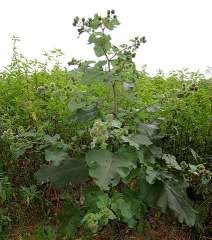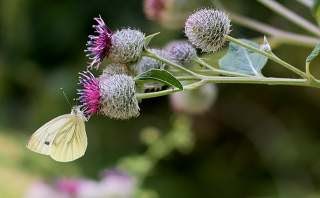Greater Burdock
 Common Names: Greater burdock, gobō, edible burdock, lappa, beggar's buttons, thorny burr, happy major
Common Names: Greater burdock, gobō, edible burdock, lappa, beggar's buttons, thorny burr, happy major
Scientific Name: Arctium lappa
Climate: Cold, Temperate, Hot
Plant Description: Biennial herbaceous plant whose size is between 100 to 300 cm. tall. The stems are branched, rough, and not too hairy, and sometimes can be ribbed. They are green, but can turn purple as the plant matures. The alternately arranged leaves are large and smooth, heart-shaped, at the end of which are large petioles. The flowers are globe and thistle-shaped, turning into strawberry-shaped seed heads. The edible root is thin with rusty brown skin and grayish-white flesh.
It is native to Europe and Asia.
Cultivation: Full sun or partial shade. It tolerates variable climates and temperatures that are between -7 ° C to 35 ° C. It adapts to various types of soils, but for better harvest, light and sandy soil is recommended. It prefers soil that maintains humidity but is drained. The ideal condition is when the rains come regularly throughout the year. It grows best in wet conditions, but it also performs well in the places with low humidity.
It propagates by seed. To sow, prepare the soil by mixing it with organic fertilizer. Cover the seeds with about 1.25 cm of soil and lightly press down. They should be planted about 15 cm apart, or in rows 30 cm apart with the plants 5 - 8 cm apart in the rows. This encourages the development of long, straight roots. The seeds germinate in 7 days. Keep the soil moist while the seed germinates. Water deeply twice a week. Growth can be strengthened with a fertilizer, but it is not necessary.
For the most effective harvest, water the soil deeply one day before digging. Root out in the fall of the first year. During the summer, the leaves can be cut for a multitude of uses, including a cover material in the forest, or animal fodder.
The seed is obtained after the seed pods have dried, in the second year of the age of the plant.
 Uses: Greater burdock has culinary and medical uses. The leaves are used in the treatment of the scalp, skin problems, burns and to treat ulcers. The roots are used in liver treatment and to stimulate the digestive system. It is a detoxifying and diuretic herb and has also been used as an antidote in some cases of poisoning. The roots stimulate digestion and sweating. It is used to treat gout, liver and kidney ailments, rheumatism and gonorrhea.2 The roots contain high levels of inulin, traditionally are used to treat diabetes. Greater burdock seeds have "powerful inhibitory effects" on the growth of tumors caused by cancers such as pancreatic carcinoma.3 It has good amounts of vitamin B6, potassium and magnesium. The young root can be pickled to eat, or the dried root can be cooked in broth or tea.
Uses: Greater burdock has culinary and medical uses. The leaves are used in the treatment of the scalp, skin problems, burns and to treat ulcers. The roots are used in liver treatment and to stimulate the digestive system. It is a detoxifying and diuretic herb and has also been used as an antidote in some cases of poisoning. The roots stimulate digestion and sweating. It is used to treat gout, liver and kidney ailments, rheumatism and gonorrhea.2 The roots contain high levels of inulin, traditionally are used to treat diabetes. Greater burdock seeds have "powerful inhibitory effects" on the growth of tumors caused by cancers such as pancreatic carcinoma.3 It has good amounts of vitamin B6, potassium and magnesium. The young root can be pickled to eat, or the dried root can be cooked in broth or tea.
Its broad leaves make a good blanket around established trees and serve as fodder for animals. Its flowers provide a source of nutrients for bees.
Pests and Diseases: Greater burdock is relatively pest free. But its roots are eaten by the larva of the ghost moth (Hepialus humuli).
In general it can be considered a weed if not harvested.
To prevent the plant from becoming troublesome, harvest the root in the fall of the first year or spring of the second. The seed that reaches maturity must be harvested immediately.
References:
- https://pfaf.org/user/plant.aspx?LatinName=Arctium+lappa
- http://www.bio.brandeis.edu/fieldbio/medicinal_plants/pages/Great_Burdock.html
- http://www.medicinacomplementar.com.br/biblioteca/pdfs/Fitoterapia/fi-0384.pdf
En español: Bardana
